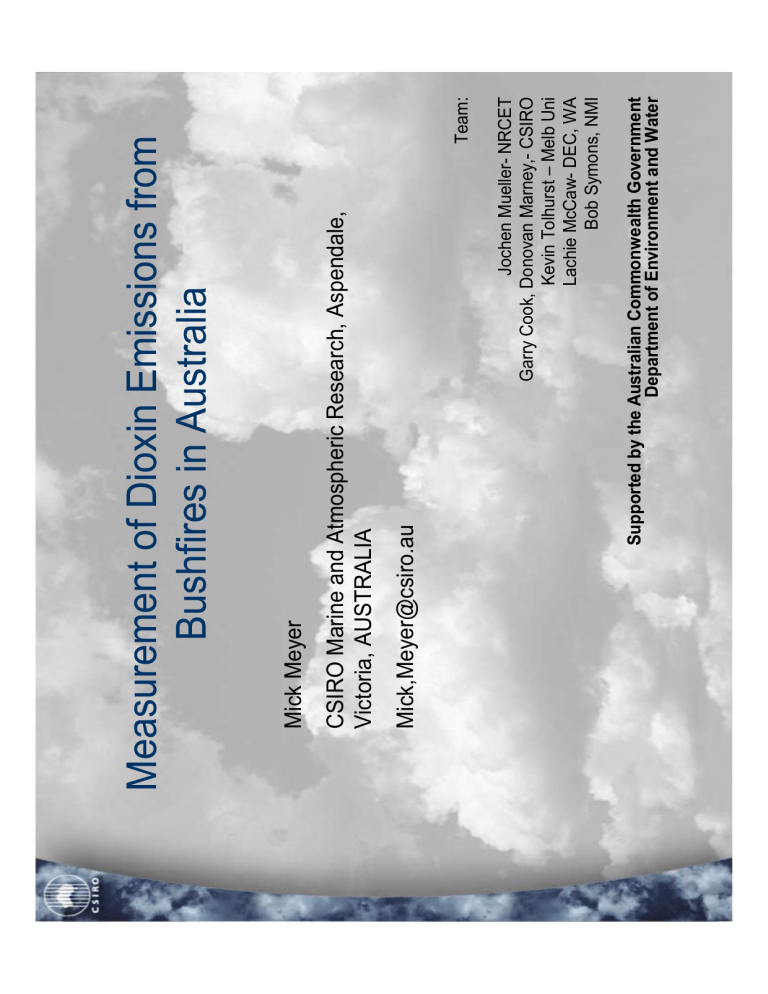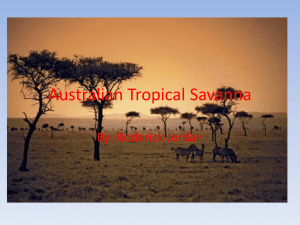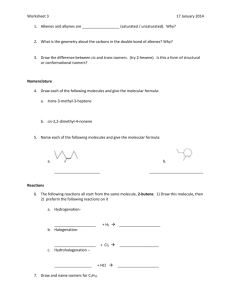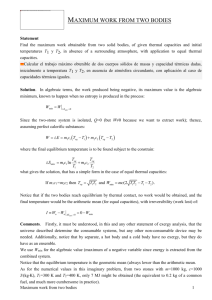m ro f
advertisement

Jochen Mueller- NRCET Garry Cook, Donovan Marney,- CSIRO Kevin Tolhurst – Melb Uni Lachie McCaw- DEC, WA Bob Symons, NMI Team: Supported by the Australian Commonwealth Government Department of Environment and Water Mick,Meyer@csiro.au CSIRO Marine and Atmospheric Research, Aspendale, Victoria, AUSTRALIA Mick Meyer Measurement of Dioxin Emissions from Bushfires in Australia That produces a lot of dioxins 8% of Australia 16% of NT,10% of WA, 6% of Qld. In 2006: 66 Mha • listed in the Stockholm Convention on POPs • 7 PCDDs, 10 PCDFs are assigned toxicity weightings • the 2,3,7,8 dioxins and furans are toxic • 210 PCDDs & PCDFs Dioxins National Dioxin Program (2004) Environment Australia (2002) To air 1081 18 53 2 3 0 1156 1410 82% To land 865 14 42 35 60 7 1023 1300 79% Emission g 2001 Bushfires are the largest source and the most uncertain source in the Inventory 216,173,000 3,505,000 10,588,000 3,492,000 6,044,000 653,300 1994 Emission factor ug TEQ/t To land To air 5 4 5 4 5 4 0.5 10 0.5 10 0.5 10 62- 1240 7-400 72-1700 (46%-81%) 0.5-10 0.5-28 Mass (t) 3.5-68 Emission (g TEQ) 0.5-10 Savanna and Temperate Grassland Prescribed burning of forests Wildfires Agricultural residues- wheat Agricultural residues- coarse grains Agricultural residues- sugar Total All sources Savanna and temperate grasslands Prescribed burning, stubble burning Wildfires Total Emission factors (ug TEQ.t) Inventories Fires Measuring emission factors Potential measurement artifacts Residues Dispersion Emerging issues Outline Fires in Australia Oct - Dec July-Sept April-June Jan-Mar M. Simon, S. Plummer, F. Fierens, J. J. Hoelzemann, and O. Arino (2004) Three estimates of global biomass burning in 2002 Africa North/Central America South America Australia Asia Europe Russia Global GBA-2000 Area (Mha) Percentage 224.6 64% 6.2 2% 11.9 3% 55.9 16% 27.1 8% 4.3 1% 22.2 6% 352.2 100% From Kasischke and Penner (2004) Australian fire scar analysis 1999/2000 = 52 Mha GLOBSCAR Area (Mha) % 121 57.4% 11 5.2% 13.8 6.5% 18 8.5% 21.2 10.1% 5.8 2.8% 20 9.5% 210.7 100.0% Global emissions Fire frequency 1998 to 2006 0 10 5 15 25 20 Sep Sep Jul Jul May May Mar Mar Percent annual regional area Percent annual regional area 30 Jan Jan 40 35 30 25 20 15 10 5 0 Nov Nov Fires are NOT fuel limited Ignition/propagation is weather dependent Fires are fuel limited There is always an ignition source When fires happen Lightning Forestry personnel Recreational users Residents/Farmers Unknown/Arson Unreported Cause Number of fires 1602 255 600 2117 1627 99 25 4 10 33 26 2 % Causes of fires in State Forests and National Parks in Victoria 1990-1999. Most fires have anthropogenic ignition causes Wildfire Causes 100 0.12 0.1 1.2 6 13 80 1 0 10 15 49 24 2 100 1.2 0 0 0 0 0 0 0 100 3.9 1.9 0.0 0 2 3 3 4 88 0.5 0.4 5 41 33 21 0 0 100 40.9 34 0 0 66 0 0 100 100 100 100 36.1 0.50 0.4 15.6 2 8 2 0 89 0.0 100 0.0 0 10 90 0 0 0 % Total carbon emitted NSW Tas WA SA Vic Qld NT ACT 8.1 100 100 2 6 3 0 89 AUST Wildfires, agricultural and prescribed fires are where most of the population live-in the South and along the East Coast Most of the emissions are from savanna woodland and arid grassland in Northern Australia where the population is low. Total % National emission %National emission excluding tropical savannah Tropical savannah Open woodland and temperate grassland Forest, Prescribed Forest, Wildfire Cereals Sugar Vegetation Australian carbon emission estimates (2000) Fraction Savanna Area Savanna fire area (ha) Fraction Savanna 1995 2000 2005 2010 0 0 1990 1x106 20x106 0.90 1980 0.92 0.94 0.96 0.98 1.00 2x106 40x106 4x106 3x106 1985 Savanna Wildfire Prescribed 5x106 60x106 80x106 100x106 Fire Area Prescribed and Wildfire Areaha Ash Wednesday, 1983 Sydney, 1992 Emission (Gg CO2-e) 0 1980 5000 10000 15000 20000 25000 20000 15000 10000 5000 0 1985 Savanna Prescribed Wildfire Inventory Annual 1990 1995 2000 2005 2010 Canberra, 2003 National Emission Timeseries Fire area (ha) 0 1980 20,000,000 40,000,000 60,000,000 80,000,000 100,000,000 1985 Top Centre Total 2002 NGGI Inter-annual Variability of Savanna Fires - 2000 1988 10,000,000 20,000,000 30,000,000 40,000,000 50,000,000 60,000,000 70,000,000 80,000,000 1995 Year 1990 Fire scar area (ha) 2005 1992 NT Top NT Centre WA Top WA Centre Total 2000 Grasslands ~80 Woodlands ~2 Range min to max Year 1996 2004 ~60% of forest/woodland Fire History in Victoria 1940-1999 Forest, woodlands, Arid Grasslands (Wildfire, Prescribed fires) (Agricultural residues) Agricultural cropping Landscape uses Fires from land clearing are very different Occur once Often on topsoils with high carbon content Fires are: A natural part of the Australian landscape Highly variable from year to year A major component of the carbon cycle How do we measure dioxin emissions • From atmospheric concentration measurements using a dual tracer technique – field method • Direct measurement – mass dioxin emitted/mass fuel burned - possible in laboratory How to determine emission factors: Fuelburned = Area x fuel load x combustion efficiency Emission = Fuel burned x emission factor Fuel dependent 0.5 - 55 ug TEQ/kg • Combustion rooms e.g. Gullett and Touati (US EPA) Low rates, OCDD dominated • Field measurements (e.g (Prange, Mueller et al. (NRCET) • Surrogate estimates were made using wood combustion heaters were made using open combustion chambers (0.5 to 30 ug TEQ/kg) Dioxin emissions from biomass burning Tracer (Ec) is total volatilised fuel carbon EPCDD [ PCDD ] = EC × Dual tracer technique [C ] Measurement Principle 50% carbon 1 kg burned fuel =500 g fuel carbon Fuel O2 500 g carbon, 1 ng TEQ PCDD/F, Raw Smoke Ambient Air 280 – 8400 m3 From ambient air 56 to 1680 g C 0.1 to 0.4 ng TEQ PCDD/F ratio =2 pg TEQ (g C)-1 From fuel: 500 g carbon, 1 ng TEQ PCDD/F Smoke plume 282 – 8402 m3 Dilution 0.2 gC m-3 0.05 pg TEQ PCDD/Fm-3 1.8 m 3 ratio =2 pg TEQ (g C)-1 Combustion The challenge is to sample sufficient smoke to get a dioxin sample that can be reliably analysed Field sampling CO2 Flow Pump Main pump Annubar Pressure sample lines SS filter Flow meter 10 x 8 Filter Pump Dioxin Trap Brass needle valve >5g C, >200 m3 air, in approx 1h Control box Gas meter TSP filter 1µm particle filter Sample inlet Tedlar bag In the Field Late season Early season Savanna Fires 13:00:00 0 50 100 150 0 200 400 600 800 14:00:00 15:00:00 16:00:00 2cm depth Surface 17:00:00 Fuel bed and soil temperatures Prescribed burn, Victoria Sugar Cane Total carbon sampled (g) Time 17.00 0 0 14.00 16.00 200 2 15.00 400 4 800 600 [CO2] Total C 1000 6 8 10 CO2 concentrations near a low intensity prescribed fire [CO2] (ppm) •Simulates a backing fire; either stubble or prescribed fuel reduction fire in forests •Smoke is sampled from the exhaust hood •Fire progresses across a fuel bed on the floor of the corridor Laboratory sampling Leaf litter Burn Temperature ( C) o 0 200 400 600 800 1000 0 5 Timecourse of fire along the bed 1 o 2 Temperature ( C) 3 10 4 5 0 200 400 600 800 1000 8 9 Time (min) 6 7 0 15 10 5 Time (min) 20 Cane 10 25 15 Straw 20 25 (sampler version 2) In the field- at close quarters For safety, you never see to fire front. The energy release is 50- 100 MW m-1 compared with 1 -5 MW m-1 for prescribed fires. The front can move at 10-20 km h-1 Wildfires Measurements Locations of field measurements Laboratory samples Species Cane PCDD 3.7 PCDF 5.1 PCB 0.2 Total 8.9 Field samples Species Cane PCDD 1.8 PCDF 0.14 PCB 0.07 Total 1.98 Sorghum 11.5 22.4 0.35 34.2 0.83 Wildfire 0.65 0.13 0.13 0.91 Forest 0.42 0.33 0.09 Prescribed 1.23 0.36 0.18 1.78 30.5 Straw 11.4 18.7 0.35 Savanna 2.03 0.16 0.07 2.3 Results Emission ratios (pg TEQ gC-1) EF in ng TEQ/kg dwt 0 10 20 30 40 50 60 G le ul N tt C G le ul OR tt N DP b la N w ra st e c A ld um W NT DP Vi Q an h N c d d d l l l ld rg rab fie fie fie fie so te L t i P P P P b P L la bND ND ND ND ND P a L D Forest and Savanna fuels F W EF in ng TEQ/kg dwt 0 5 10 15 20 25 30 t le l u G r & tw N DP l ab ra st w N DP b la rg o s m u h N DP b La ne a c Agricultural Residues C e an fie ld TCDD isomers PeCDD isomers HxCDD isomers HpCDD isomers OCDD TCDF isomers PeCDF isomers HxCDF isomers HpCDF isomers OCDF Total CDD Cane Wildfire Savanna Prescribed 1 19 4 16 1 9 3 6 2 21 6 9 11 15 10 9 79 17 51 41 4 11 25 17 0 3 0 1 0 2 0 0 1 1 0 0 2 1 0 0 93 82 74 82 Congener Profile for homologue groups (by mass) Congener 1,2,3,7,8-PeCDD 1,2,3,4,7,8-HxCDD 1,2,3,6,7,8-HxCDD 1,2,3,7,8,9-HxCDD 1,2,3,4,6,7,8-HpCDD OCDD OCDF Total CDD Cane 0 0 0 0 6 91 2 97 Wildfire 2 2 2 2 24 62 2 93 Savanna Prescribed 1 0 0 1 1 1 1 1 7 8 89 88 0 0 99 98 Congener profiles- toxic congeners by mass 2,3,7,8-TCDD 1,2,3,7,8-PeCDD 1,2,3,4,7,8-HxCDD 1,2,3,6,7,8-HxCDD 1,2,3,7,8,9-HxCDD 1,2,3,4,6,7,8-HpCDD OCDD 2,3,7,8-TCDF 1,2,3,7,8-PeCDF 2,3,4,7,8-PeCDF Total CDD Cane 12 47 5 7 2 17 3 2 0 2 93 Wildfire Savanna Prescribed 5 16 7 54 49 40 6 4 5 7 6 8 5 9 7 7 7 8 0 1 1 1 1 4 1 0 1 9 4 12 83 93 76 Congener profiles – toxic congeners by toxicity (TEQ) Boorolite 1.7 Mha fire area Are wildfires really low emitters of PCDD/PCDF ? (fg TEQ m ) -3 mass (µg m ) -3 0 May-02 200 400 600 800 0 5 10 15 20 Sep-02 Dec-02 non-sea-salt potassium mass Mar-03 Fire event Jun-03 0.0 Oct-03 0.4 0.8 1.2 1.6 non sea salt potassium PCDD/PCDF concentration PCDD/PCDF concentrations were at ambient background concentrations -3 TSP and NSS-K concentrations were very high from impact a dense smoke plume BUT The smoke plume from the NE fires impacted Boroolite in Jan/Feb (µg m ) Compare field and laboratory measurements L-straw_1 L-straw_2 L-straw_3 L-straw_4 L-straw_5 L-straw_6 L-straw_7 L_sorghum_1 L_sorghum_3 25% 50% 75% 100% % PCDD F_Cane_1 F_Cane_2 WF_Vic_1 WF_Vic_2 S_NT_1 S_NT_2 S_NT_3 S_NT_4 PF_WA_1 PF_WA_2 PF_WA_5 L_cane_4 PF_WA_3 PF_Vic_1 PF_Vic_2 PF_Vic_3 PF_Vic_4 PF_Qld_1 PF_Qld_2 PF_WA_4 0% ΣTCDDs ΣTCDFs PF_Qld_3 PF_Qld_4 0% 25% % PCDD 50% ΣTCDFs ΣTCDDs 75% 100% Field measurements L_cane_1 L_cane_2 L_cane_3 litter_Vic1-1 litter_Vic1-2 litter_Vic1-3 litter_Vic2 litter_Qld Laboratory tests 0 100 Mass emissions 300 pg (g C)-1 200 400 500 600 O D D C O D C F field, prescribed, n=13 field, cane, n=2 lab, sorghum, n=3 field, prescribed, n=13 field, wild, n=2 field, savanna, n=3 field, cane, n=2 lab, forest, n=5 lab, cane, n=3 lab, sorghum, n=3 lab, straw, n=7 PCDD/PCCF homologue mass profiles D D DD D D C D D -T PeC xC xCD CD DD DD F F 8 7 , - -H H x C C D D F F 3, ,7,8 7,8 ,8- 9-H -Hp O -TC eC CD CD DF F F , e 2 ,3 4, ,7 8, ,8 D 8 F 7, ,8-P 8-P -Hx HxC xC CD D DF F 2 ,3, ,6 ,7, ,7 , , 3 ,7 7, ,8 8- -H Hx pC C D 1 ,2 ,3 ,3 ,6 , 2 ,3 4, ,7 7, ,8 9- -H p C 1 1,2 ,2 3,4 1 2, ,2 ,3, 3,4 ,6, 6,7 ,8, ,8 ,9-H O 1 , 2 ,2, ,3 4, ,7 6,7 ,8 1 1 1,2 ,3, 2,3 ,4, 4,7 2 1, ,3 3, 2 , 1, 1,2 10 9 8 7 6 Toxic emissions 5 -1 pg Teq (g C) 4 3 2 1 0 field, prescribed, n=13 field, cane, n=2 lab, sorghum, n=3 field, prescribed, n=13 field, wild, n=2 field, savanna, n=3 field, cane, n=2 lab, forest, n=5 lab, cane, n=3 lab, sorghum, n=3 lab, straw, n=7 PCDD/PCCF toxic congener profiles And we see PCDD/PCDF production In furnaces, in slow combustion heaters and in open fire places the combustion gases are retained at high temperature in the flue. • heterogeneous chemistry at 200 - 450oC. • gas phase chemistry at 400 – 600oC Dioxins form by Mechanisms Leaf litter Burn Temperature C o 0 200 400 600 800 1000 0 20 Timecourse of fire along the bed o 40 0 200 400 600 800 1000 0 Time (min) Temperature ( C) 60 5 80 6 10 10 5 4 9 3 2 15 20 100 Leaf litter Time (min) 1 7 Straw- fan assisted 25 Mass Emission PCDD+PCDF (pg gC-1) PCDD fraction (%) 0 0 200 400 400 Natural Ventilation Forced ventilation 200 600 600 Mean Corridor Temperature (C) 0 20 40 60 80 100 0 500 1000 1500 2000 With fan-assisted ventilation air flow is more turbulent and smoke residence time is shorter This is very difficult to reproduce precisely therefore laboratory tests should be interpreted with caution. In the open, ambient air is entrained into the smoke plume. It rapidly dilutes and rapidly cools Who else has seen these patterns 0 1 2 3 4 5 Congener All HW HW-C low flow HW-C2-low-dry HW-C2-hi_dry HW-NC-dry-lo HW-C2-low-dry HW-C1-low-dry HW-C-hi-wet HW-C-hi-dry HW-oload HW-C low flow HW-C high flow HW open fireplace All Pine MF All HW Mean 4 ng TEQ (g fuel)-1 Furans dominate D D DD DD D D TC eC xC CD CD DD DD F F F x 8 P C C CD D D F F F 7 , 8 - -H -H H x p D C 3, ,7, ,7,8 7,8 ,9- 8-H O ,8-T Pe eC xC CD CD DF DF F F , x x xC C P 2 ,3 ,4 6, ,8 7, ,7 ,8 8- -H H CD D , 2 , 7 ,3 3,7 ,7, 7,8 ,8- ,8-H 9-H -Hp Hp OC 1, ,2,3 2,3 ,3, 4,6 2 , 7 , , , 4 8 , , 7 , ,4 , 1 1 1,2 ,3 9 , 8 2 1, 2,3 2,3 ,3,6 4,6 ,7, ,6,7 ,8, 2 7 , 1, 1, 1,2 2,3 ,2,3 3,4 ,4, 1 ,2, ,3 1 1,2 Emission (ng -1 kg fuel ) 6 7 8 9 10 (Gras et al. , 2002) Slow combustion woodheaters Gullett and Touati (2003) saw similar patterns for wheat and rice Prange et al., (2002) Dioxins in smoke, Combustion hood test Hawaii Florida Florida Florida I II II leaves Also Oregan and North Carolina forest fuels Gullett et al. (2006) 1 10 100 1000 Sugar Cane- burn hut Emission (ng TEQ g C-1) - Fuel (residues, or formation chemistry) – possible but not large Soil (volatilisation or formation from pyrolysis of soil carbon - some evidence for this in recent work Fractionation of smoke in the field (flaming combustion smoke rises in the plume, smouldering remains) - Little evidence that this occurs to any substantial extent Sampling artifacts - Most likely in our study Why the differences 0 Height 200 400 600 Is it fuel? Is it soil? Tropical Coastal There is something in the location of the fire. Cluster analysis of field emission factors by PDCC/PDCF homologue groups F-Cane-1 PF-Qld-4 PF-Qld-3 S-NT-4 PF-Qld-1 PF-Qld-2 F-Cane-2 WF-Vic-1 PF-WA-4 PF-WA-3 PF-WA-2 WF-Vic-2 S-NT-2 PF-WA-1 PF-Vic-2 PF-WA-5 PF-Vic-1 S-NT-3 PF-Vic-4 PF-Vic-3 -3 0 2 4 6 8 10 0 2.5% 0.2 97.5% 0.6 PCDD/F & PCB emission (kg TEQ) 0.4 0.8 Down from 70-1700 1 All sources Revised Emissions 142g TEQ (30-490) 1994 – Revised EA (2002) Frequency (10 ) 216,173,000 3,505,000 10,588,000 3,492,000 6,044,000 653,300 Mass (t) Emission factor ug TEQ/t To air To land 5 4 5 4 5 4 0.5 10 0.5 10 0.5 10 Emission g To air To land 1081 865 18 14 53 42 2 35 3 60 0 7 1156 1023 1410 1300 82% 79% Revised To air 230 3 4.7 2.9 5 0.45 246.05 500 49% Emissions to air reduce by a factor of 4, but still comprise 50% of emissions (with a high range of uncertainty) Savanna and Temperate Grassland Prescribed burning of forests Wildfires Agricultural residues- wheat Agricultural residues- coarse grains Agricultural residues- sugar Total All sources 2001 Estimates UNEP toolkit Fuel (32 pg) Fuel 0.18 0.1 0.61 2 29 0.2 0.1 0.1 0.05 0.02 32.4 Homologue group Total TCDD isomers Total PeCDD isomers Total HxCDD isomers Total HpCDD isomers OCDD Total TCDF isomers Total PeCDF isomers Total HxCDF isomers Total HpCDF isomers OCDF Total Ash (34 pg) Smoke (238 pg) 1.2 0.6 0.1 0.1 283.8 pg ( g fuel) Smoke 10.3 15.5 26.9 40.4 182.2 6.4 -1 0.2 0.2 0.1 0.1 34.1 Ash 0.2 0.2 1.9 4.1 27.0 0.3 Mass Balance- Coastal savanna woodland Residues Smoke plumes are transported hundreds to thousands of kilometers Where the smoke contacts the surface, there is surface deposition Dispersion- where does it fall Northing (km) Northing (km) 100 500 600 700 800 900 300 400 500 600 700 800 900 Easting (km) 7900 200 7900 8200 8300 8400 8500 8600 8700 8000 100 Grid Centre Jabiru PM2.5 (kg ha-1), Aug. - Sept. 04 7900 8000 0 Darwin 400 8100 -200 -100 (c) 300 Easting (km) 200 8000 8100 8200 8300 8400 8500 8600 8700 8100 8200 8300 8400 8500 8600 8700 7900 0 8000 15 20 25 30 5 Grid Centre Jabiru 8100 0 Darwin PM2.5 (kg ha-1), April - May 04 10 -200 -100 (a) 8200 8300 8400 8500 8600 8700 -200 -100 (d) -200 -100 (b) 100 0 100 Darwin 0 Darwin 300 400 300 400 Easting (km) 200 Grid Centre Jabiru 500 600 700 800 500 600 700 800 900 900 PM2.5 (kg ha-1), Oct. - Nov. 04 Easting (km) 200 Grid Centre Jabiru PM2.5 (kg ha-1), June - July 04 PM2.5 Emissions (kg ha-1) Northing (km) Northing (km) -200 8000 8200 8400 8600 -200 8000 8200 8400 8600 8800 8800 Northing (km) Northing (km) 0 Darwin 0 Darwin (a) Jabiru 600 800 400 600 800 (c) PM2.5 (µg m-3), Aug. - Sept. 04 Easting (km) 200 400 Easting (km) 200 Jabiru PM2.5 (µg m-3), April - May 04 30 35 400 600 800 25 -200 400 Easting (km) 600 800 5 5 200 10 10 8200 0 15 15 8000 20 20 8400 25 30 Jabiru (d) PM2.5 (µg m-3), Oct. - Nov. 04 Easting (km) 200 5 10 15 20 25 30 30 8600 Darwin 0 Jabiru 35 35 8800 -200 8000 Darwin (b) PM2.5 (µg m-3), June - July 04 35 5 10 8200 15 20 8400 25 8600 8800 PM2.5 Surface Concentrations Northing (km) Northing (km) 270 225 315 180 0 0 20 60 45 135 80 90 In the late fire season, some is transported SW to NW WA. A large proportion is transported into the Timor Sea 100 Apr - May Jun - Jul Aug - Sep Oct - Nov 2004 PM2.5 (Gg) 40 Total emitted 668 Gg Where does it end up: PM2.5 leaving the domain Quantifying the emissions is only the start- to understand impacts of dioxins we first need to understand the dispersion and deposition. Slash burns from forest clearing Peat fires in forests other fuels and soils may have different emissions Soil pyrolysis. What happens when there is substantial soil heating e.g. But that may not be universal – The impact may be distant from the source. Emissions to land require review Long-range transport can be significant careful measurement protocols are required The emissions in Australian ecosystems are low Measurement artifacts may be a problem Conclusions/ Emerging Area







